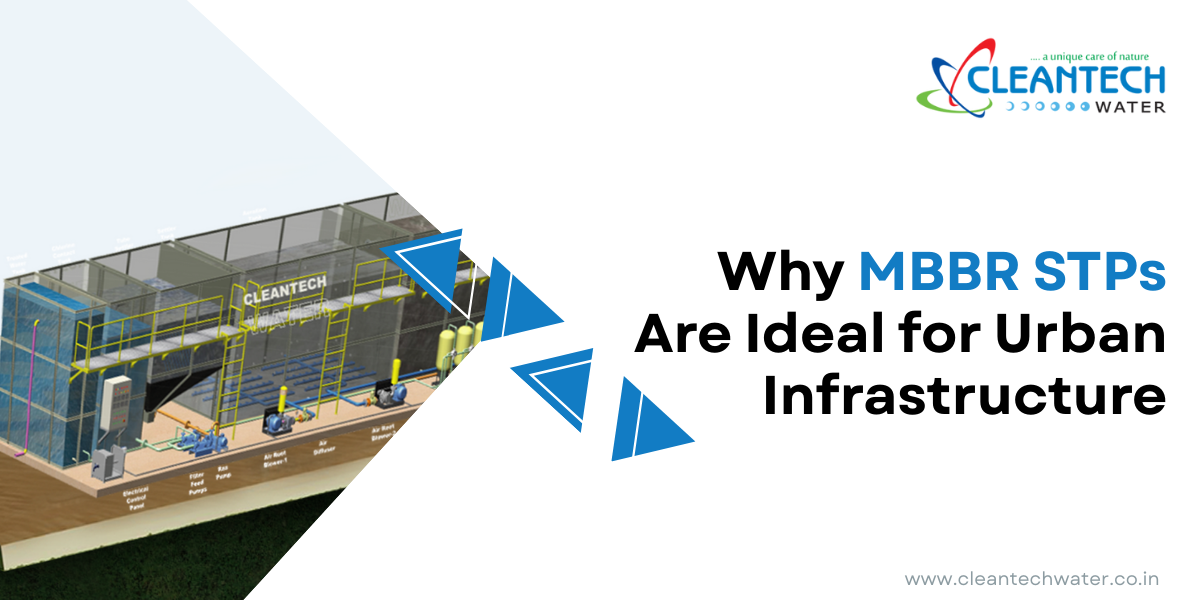As India’s urban landscape continues to expand rapidly, the need for efficient, compact, and sustainable wastewater management systems has never been more critical. Traditional solutions often fall short in densely populated urban areas where space is limited, operational costs are a concern, and environmental compliance is becoming increasingly stringent. In this context, the MBBR (Moving Bed Biofilm Reactor) sewage treatment plant emerges as a game-changer for modern infrastructure. Designed to meet the challenges of urban sewage treatment, MBBR technology offers a range of advantages that make it a preferred choice for property developers, industries, and municipalities.
MBBR sewage treatment plants are built to handle high organic loads, require minimal space, and deliver consistent performance. Whether you’re planning a new facility or upgrading an existing one, understanding its benefits can help you make a smart investment in your infrastructure. Let’s explore the top 10 advantages of incorporating MBBR plants into urban projects.
10 Advantages of Using MBBR Sewage Treatment Plants
1. Space-Saving Design
One of the most significant advantages of an MBBR sewage treatment plant is its compact footprint, making it ideal for urban environments where real estate is at a premium. Unlike traditional systems that require large settling tanks and extensive land area, MBBR systems utilise specially designed biofilm carriers suspended in aeration tanks to maximise surface area for microbial growth.
Moreover, the modular and vertical design of MBBR plants allows for flexible installation in basements, rooftops, or compact utility zones. This space efficiency is particularly advantageous for residential complexes, commercial buildings, and industrial units located in high-density areas, where land availability often limits infrastructure development.
2. High Treatment Efficiency
MBBR systems are renowned for their enhanced biological treatment capabilities, particularly in degrading organic matter and reducing biochemical oxygen demand (BOD) and chemical oxygen demand (COD) levels. The biofilm carriers facilitate optimal microbial activity by providing a large protected surface area where bacteria can thrive and break down pollutants effectively.
Another major benefit is the system’s consistent performance under variable load conditions, a common scenario in urban settings due to fluctuating water usage patterns. MBBR sewage treatment plant can handle these variations without compromising treatment quality, ensuring that the treated water consistently meets environmental discharge standards. This reliability makes MBBR a trusted solution among wastewater treatment plant operators and property managers.
3. Easy to Retrofit into Existing Systems
Urban infrastructure often includes older sewage treatment systems that are either underperforming or non-compliant with current environmental norms. MBBR technology offers a cost-effective and seamless solution for upgrading such systems. Its modular design allows it to be retrofitted into existing treatment plants without requiring a complete overhaul.
Installation can be done with minimal civil modifications and little operational downtime, enabling businesses and residential communities to improve their wastewater treatment capacity while maintaining day-to-day functionality. This adaptability is a key reason why many sewage treatment plant manufacturers in India recommend MBBR solutions for urban retrofitting projects.
Get a Quote for MBBR STP Installation
4. Low Maintenance Requirements
One of the most appealing features of an MBBR sewage treatment plant is its low maintenance demand, which significantly reduces long-term operational costs. The system employs a self-regulating biofilm process, where microorganisms grow on specially designed plastic carriers suspended in the aeration tank. These carriers continuously move within the tank, ensuring even exposure to wastewater and oxygen, which helps maintain a healthy and active microbial population without the need for constant manual oversight.
Unlike conventional wastewater treatment systems that often require regular backwashing, chemical dosing, or manual sludge removal, MBBR systems are designed to operate with minimal operator intervention. The moving media prevents clogging and excessive sludge build-up, which are common issues in traditional fixed-film or activated sludge processes. Additionally, the robust nature of the biofilm makes it resistant to toxic shock loads and fluctuating wastewater conditions, reducing the need for emergency maintenance or system recalibration.
For property owners and businesses, this translates to lower manpower requirements, fewer mechanical breakdowns, and minimal operational disruption—making MBBR plants a smart, low-hassle investment. Whether you’re managing a residential complex, hotel, hospital, or industrial facility, the reduced maintenance burden of an MBBR system provides peace of mind while ensuring regulatory compliance with minimal effort.
5. Energy Efficiency
A significant advantage of installing an MBBR sewage treatment plant in urban infrastructure is its energy-efficient design. Compared to conventional systems that often rely on large mechanical components and energy-intensive processes, MBBR technology optimises treatment with minimal energy input. The biofilm carriers used in the system enhance biological treatment without requiring additional power for their movement, as they are agitated simply through aeration or water flow.
This reduced energy requirement contributes to lower operational costs, which is especially beneficial for businesses and property developers aiming for sustainable operations. Additionally, MBBR systems align with global and local eco-friendly practices by minimising carbon footprint, making them ideal for green building projects, LEED certifications, and smart city initiatives. For investors and property owners, energy efficiency not only reduces utility bills but also supports long-term environmental goals.
6. Scalability and Flexibility
Urban infrastructure is dynamic—expansions, new constructions, and population growth demand flexible and scalable wastewater solutions. MBBR sewage treatment plants are inherently modular, making them easy to adapt to changing capacity requirements. Whether it’s a small residential building today or a multi-tower complex tomorrow, the same MBBR system can be expanded or upgraded without major reconstruction.
This adaptability is particularly useful for phased development projects in urban areas, such as township planning or industrial estates. Property owners can begin with a smaller setup and scale operations in alignment with occupancy or usage patterns. Sewage treatment plant manufacturers often design MBBR systems to accommodate future growth, ensuring clients don’t have to overspend upfront while preserving the option to expand later.
7. Resistant to Load Fluctuations
Urban wastewater systems often face inconsistent inflow patterns, especially in residential and commercial areas where usage fluctuates between day and night or weekdays and weekends. Unlike conventional systems that struggle to cope with these variations, an MBBR sewage treatment plant maintains stable performance even during peak and off-peak loads.
The biofilm carriers act as shock absorbers, retaining active microorganisms that continue to degrade waste even when influent conditions change. This resistance to load fluctuation ensures the system consistently meets discharge standards and prevents the release of partially treated wastewater. For property owners and municipalities, this means reliable operation without the risk of fines or environmental violations due to treatment lapses.
8. Minimal Sludge Production
Another key benefit of the MBBR process is its low sludge generation compared to conventional sewage treatment technologies. The efficient degradation of organic matter by biofilm reduces the volume of residual sludge, resulting in fewer requirements for sludge handling, transportation, and disposal.
This not only saves on recurring disposal costs but also simplifies compliance with sludge management regulations. For urban setups where space and infrastructure for sludge treatment are limited, the low-sludge characteristic of MBBR plants becomes a critical advantage. Many wastewater treatment plant operators choose MBBR for this very reason, especially in commercial properties, hospitals, and institutional campuses.
9. Long Operational Life
Durability is a hallmark of modern MBBR sewage treatment plants. Built with high-quality, corrosion-resistant materials and engineered for minimal mechanical wear, these systems are designed to offer a long service life with minimal component failure. The absence of moving parts in the biofilm system further enhances operational stability.
For property developers and facility managers, investing in a robust system means fewer replacements, reduced downtime, and long-term cost savings. With proper upkeep and occasional inspections, an MBBR plant can continue to perform efficiently for decades, making it a valuable asset in any urban infrastructure project.
10. Compliance with Stringent Discharge Norms
Today’s urban developments must adhere to rigorous wastewater discharge regulations to avoid penalties and protect the environment. MBBR sewage treatment plants are engineered to meet and often exceed these standards, consistently delivering high-quality treated water that is safe for discharge or reuse.
By effectively reducing BOD, COD, nitrogen, and suspended solids, MBBR systems help cities and properties maintain compliance with Central Pollution Control Board (CPCB) norms and local municipal requirements. This compliance also supports broader sustainability goals by contributing to cleaner rivers, lakes, and public health, reinforcing a brand’s environmental credibility and corporate responsibility.
Ready to Invest in a Smarter, Greener Future with an MBBR Sewage Treatment Plant?
Choosing the right wastewater solution is not just about compliance—it’s about making a long-term investment in efficiency, sustainability, and operational peace of mind. An MBBR sewage treatment plant offers all of this and more. Whether you’re a property developer planning a high-rise complex, a business owner expanding your operations, or a facilities manager upgrading outdated infrastructure, MBBR technology is the smart choice for modern urban needs.
With its compact design, low energy consumption, minimal maintenance, and reliable performance under fluctuating loads, MBBR systems stand out as one of the most cost-effective and future-ready sewage treatment options available today. As India continues to urbanise, integrating sustainable wastewater solutions is not only a necessity—it’s a responsibility.
Partner with Cleantech Water, a leading sewage treatment plant manufacturer that understands your unique requirements and offers end-to-end support, from design and installation to after-sales service. Let us help you build cleaner, compliant, and more efficient infrastructure for tomorrow’s cities.
Get in touch with our expert team today at +91-9558996411 or email your queries at info@cleantechwater.co.in and take the first step toward installing an advanced MBBR sewage treatment plant tailored to your project.


